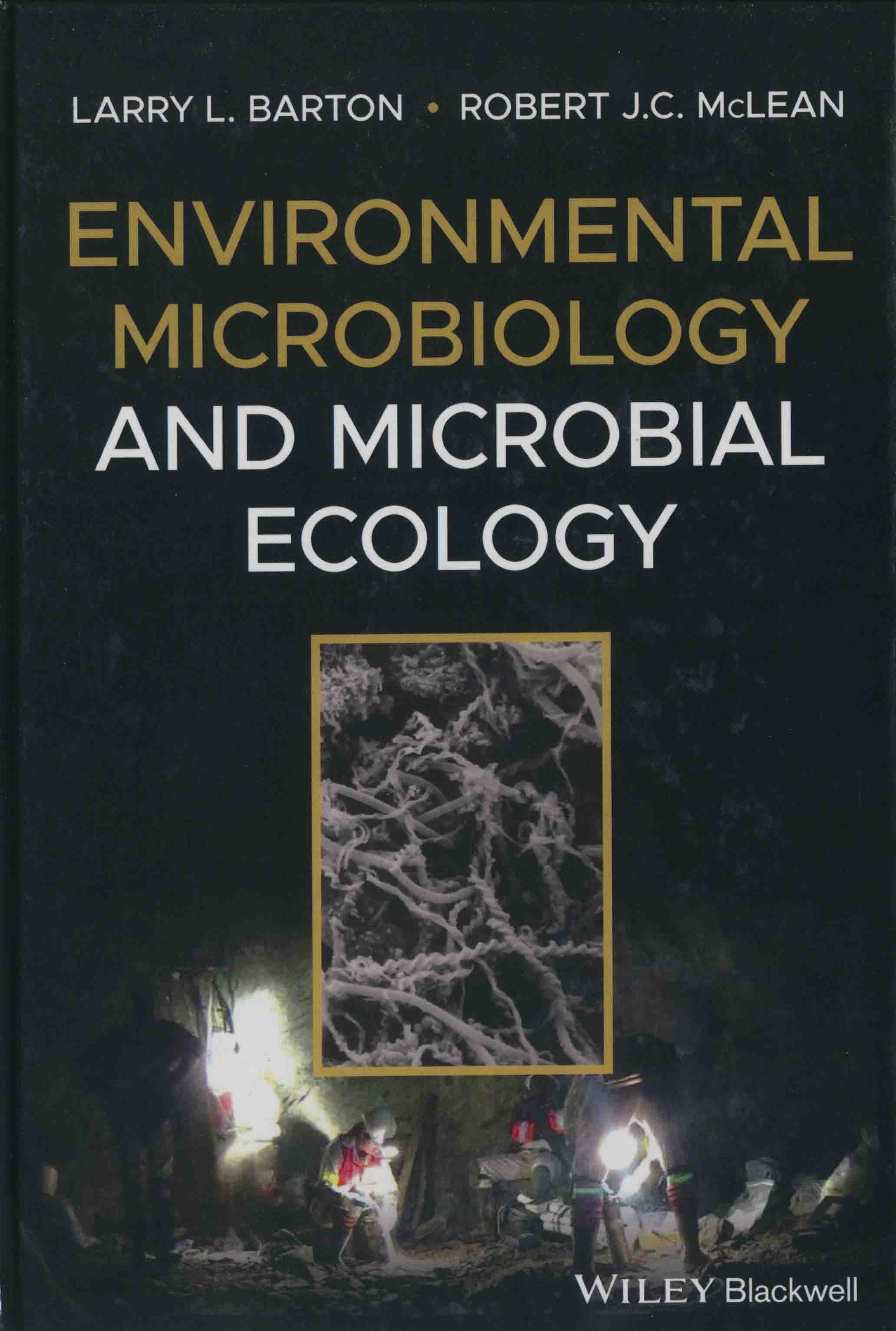 |
Environmental microbiology and microbial ecology / Larry L. Barton and Robert J. C. McLean. -- Hoboken, NJ : John Wiley & Sons, 2019. – (58.66/B293) |
Contents
Preface xv
1 Introduction to Microorganisms and Their
Activities 2
1.1 Central Themes of Environmental
Microbiology and Microbial Ecology
1.2 Are the Terms Prokaryotes or Eukaryotes
Relevant? 1
1.3 Major Approach to Study
Microorganisms 5
1.4 The Impact of Horizontal Gene Transfer
Between Microorganisms 7
1.5 What Determines Which Microorganisms are
Present? 12
1.6 Is the. Size and Shape of a Prokaryotic
Cell Important? 19
1.7 Microbial Predation 23
1.8 Summary
2S
Discussion Questions 25
References 26
Further Reading 31
2 Microbes
in the Biosphere: Examination, Cultivation, and Communities 33
2.1 Overview and Focus 33
2.2 Microscopy to Study Environmental
Microbes 33
2.3 Internal Structures in Prokaryotes 41
2.4 Strategies for Culturing
Microorganisms 44
2.5 Molecular Detection 49
2.6 Examining Bacteria that Do Not Grow as
Pure Cultures in the Laboratory 56
2.7 Microbial Community Structures 59
2.8 Summary
67
Discussion Questions 68
References 68
Further Reading 75
3 Terrestrial Systems: Soil and Subsurface
Environments 77
3.1 Overview and Focus 77
3.2 Soil: An Environment for
Microorganisms 77
3.3 Soft Microbiology 80
3.4 Understanding Soil Ecosystems 85
3.5 Subsurface Microbiology 90
3.6 Deep Subsurface Microbiology 95
3.7 Life in Deep Subsurfaces 103
3.8 Geomicrobiology 106
3.9 Summary
110
Discussion Questions 111
References 111
Further Reading 116
4 Aquatic
Surface Environments: Freshwater, Marine, and Wastewater 117
4.1 Overview
and Focus 117
4.2 Water
as Relevant to Microbial Growth 117
4.3 Marine Environments and Associated
Microbiomes 119
4.4 Freshwater Environments and Associated
Microbiomes 131
4.5 Maintaining Populations in Low Nutrient
Environments 144
4.6 Aquaculture
Wastewater 148
4.7 Hormone
Degradation in Fresh Water 149
4.8 Human
Activities and Influence on Microbial Ecology
150
4.9 Drinking
Water 151
4.10 Municipal
Water Treatment 151
4.11 Wastewater
Treatment Systems 152
4.12 Alternative Approaches for Wastewater
Treatment 154
4.13 Coliforms
and Other Indicator Organisms 155
4.14 Viruses
in Aquatic Environments: Diversity and Activity
156
4.15 Summary 158
Discussion Questions 159
References 159
Further Reading 166
5 Life
in Extreme Environments 167
5.1 Overview 167
5.2 Sampling
in Extreme Environments .168
5.3 Extreme
Temperature Environments 173
5.4 Xerophiles
180
5.5 Piezophiles 182
5.6 Acidophiles 183
5.7 Alkaliphiles 187
5.8 Halophiles and Chaophiles 189
5.9 Radioresistant Microorganisms 194
5.10 Membrane Adaptations to Extreme
Conditions 195
5.11 Astrobiology 197
5.12 Nutrient Limited Environments 198
5.13 Volcanic Surfaces 200
5.14 Summary
202
Discussion Questions 202
References 202
Further Reading 209
6 Mutualism: Microorganisms and
Terrestrial Plants 221
6.1 Overview and Focus 211
6.2 Cyanobacteria and the Chloroplast
Ancestor 211
6.3 Lichens: Cyanobacteria/Algae-Fungi
Mutualism 217
6.4 Mutualisms with Cyanobacteria as
Intracellular or Epiphytic Organisms 220
6.5 Rhizobia-Legume Symbiosis 224
6.6 Frankia and the Non-legume Nitrogen-fixing
Nodule 231
6.7 Mycorrhizae 233
6.8 Patterns of Regulation for Plant-Microbe
Mutualism 237
6.9 Bacterial-Fungal Interactions 238
6.10 Endophytic Microorganisms 240
6.11 Microbiology of the Phyllosphere 241
6.12 Summary
242
Discussion Questions 243
References 243
Further Reading 247
7 Mutualism:
Microorganisms and Animals 249
7.1 Overview and Focus 249
7.2 Building a Microbial Community - The Role
of the Host 249
7.3 Host Models to Study Parasite
Relationships 251
7.4 Digestive Tract Environment 252
7.5 The Human Microbiome 260
7.6 Gut Microbiota across the Animal
World 269
7.7 Insect-Fungus Symbiosis 279
7.8 Mutualisms Involving Insects and
Bacteria 282
7.9 Mutualisms Involving Invertebrates 285
7.10 Summary
288
Discussion Questions 289
References 290
Further Reading 295
8 Microbes
Driving the Nutrient Cycles 297
8.1 Overview and Focus 297
8.2 Nutrient Cycles and What Drives Them 297
8.3 The Aerobic Environment 299
8.4 Carbon- A Renewable Resource 304
8.5 Nitrogen for Biosynthesis and Energy 312
8.6 Sulfur Cycling 319
8.7 Cycling of Trace Elements 324
8.8 Phosphorus Cycling 328
8.9 Selenium Cycling 330
8.10 Cycling Toxic Elements 331
8.11 Summary
335
Discussion Questions 335
References 336
Further Reading 340
9 Bioremediation
Using Microorganisms 341
9.1 Overview and Focus 341
9.2 Microbial Bioremediation: Strategies and
Applications 341
9.3 Organic Compounds and Xenobiotics
Degraded 347
9.4 Design of Systems for Bioremediation 362
9.5 Summary
364
Discussion Questions 364
References 365
Further Reading 370
10 Biocorrosion and Geomicrobiology 371
10.1 Overview and Focus 371
10.2 Microbially
Influenced Corrosion (MIC) of Ferrous Metals
371
10.3 Bioalteration of Rocks, Monuments, and
Other Surfaces 376
10.4 Biodeterioration of Concrete 380
10.5 Mineral
Interaction and Biomineralization 382
10.6 Interactions with Transition and Rare Earth
Elements 387
10.7 Toxic Elements 389
10.8 Metallic and Metalloid Nanoparticles of
Microbial Origin 391
10.9 Summary
393
Discussion Questions 393
References 394
Further Reading 398
11 Microbial Communities and Metabolic
Networks 399
11.1 Overview and Focus 399
11.2 Examples of Succession of Populations 399
11.3 Impact of Climate Change on
Microorganisms 403
11.4 Syntrophy and Co-metabolism 406
11.5 Ecosystem Created by Hydraulic Fracturing
in Shale 408
11.6 Extracellular Electron Transport 408
11.7 Cross-talk: Interkingdom Signaling 410
11.8 Evolving Systems of Interest 412
11.9 Summary
424
Discussion Questions 425
References 425
Further Reading 433
Index 435